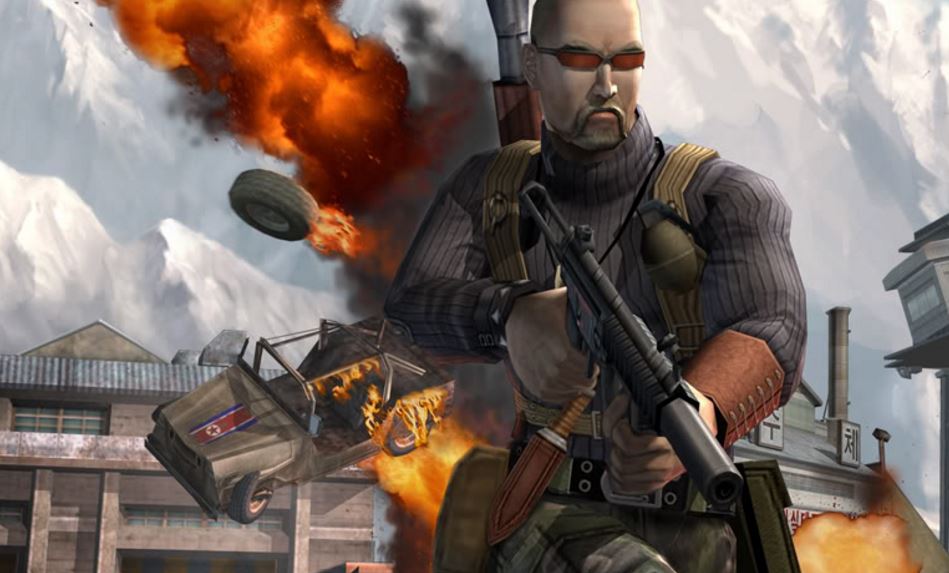I’ve been playing a great deal of Ghost Recon: Wildlands since its release, almost exclusively in coop with people from my ArmA 3 group.
As fans of ArmA, we have come to accept a certain level of jank and obtuse behavior from our favorite game, and in fact I believe that jank has become a significant glue that holds our weekly events together; it provides something to laugh at and play around with to break up the more dire and serious moments that come with a military simulator. This jank is present in Wildlands as well; although it is a much more stable and reliable game, there are just enough physics glitches and questionable things going on each session to create an endearing sense of bumbling goofiness beneath all of the nasty cartel business. All of this “tactical jank” lately has served to remind me of a beloved game from my past; Mercenaries: Playground of Destruction, the original military sandbox.
Grab a snack and get comfy while we take a trip down memory lane.
a different kind of sandbox

Released in January 2005 after a simple, catchy marketing campaign (quite simply, “blow the crap out of everything”), Mercenaries was a new breed of open world game. Until then, the genre had been dominated by criminal stories and environments, chief among them being Grand Theft Auto, with the acclaimed GTA: San Andreas released only a few months prior in October 2004.
Mercenaries eschewed the gangs, cops and absurd drive-thru orders for a setting and scenario more at home in a Tom Clancy geopolitical thriller – a speculative near-future (2009) multinational military intervention in North Korea following a military coup and the discovery that the new regime is attempting to supply terrorist factions with nuclear weapons.
The setup is brilliant in its ability to create a compelling world for gameplay, as opposed to just a story better suited to a non-interactive medium. In response to the murder of peace delegates from both Koreas by main villain Choi Song and his forces (including his own father, the peace-seeking North Korean president) and the discovery of a North Korean freighter delivering nukes to Indonesian terrorists, American, Chinese and South Korean forces deploy to the DMZ and beyond. You choose from one of three mercenaries at the start; Chris (Phil LaMarr), an American Delta Force operator with higher health, Jennifer (Jennifer Hale), an ex-Mi6 operative with better stealth capabilities, and posterboy Matthias (Peter Stormare), the fast-moving, destruction-obsessed Swede.
In addition to their special perk, each merc also speaks a second language that corresponds with one of the major factions in the game, allowing you to understand certain conversations the other mercs cannot. With only your support operative Fiona in your ear, you are dropped into war-torn North Korea with the goal of bringing down Song’s regime without the red tape. With the freedom of a merc and the arsenals of several military/paramilitary factions at your disposal, you have a perfect recipe for an open-world game.
the players
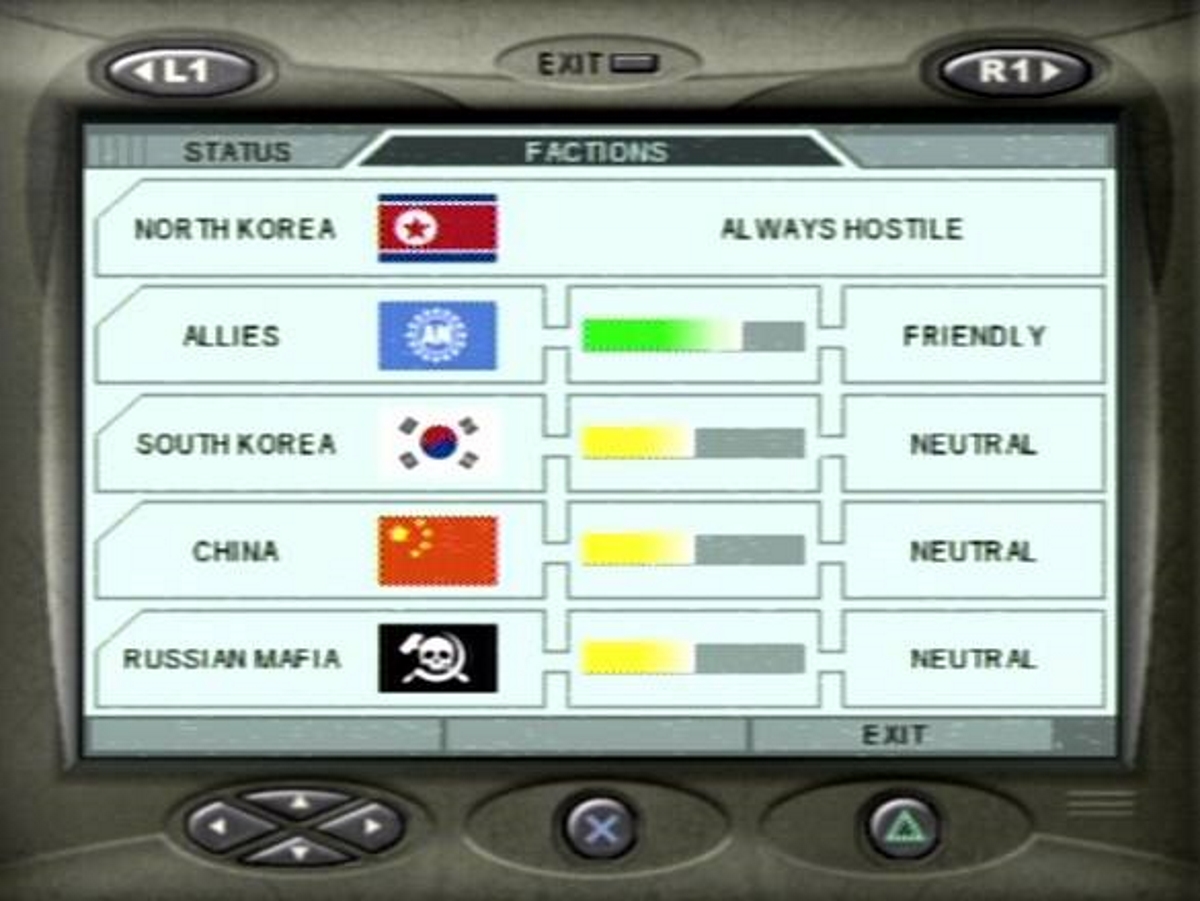
The factions, while ostensibly working together, are at odds behind the scenes. Missions for one faction can sometimes damage your standing with another, as can other actions like killing civilians or destroying faction assets; get low enough and the faction will turn hostile, with your only recourse being to bribe them to get back into their good graces. Tensions between the Chinese People’s Liberation Army and the CIA-backed South Korean Army are particularly high; their conflict is a major story focus and their missions often have you sabotaging the other as they jockey for control of post-war North Korea. Colonel Peng of the PLA and Agent Buford, the chubby, burned out CIA operative pulling the South Korean’s strings, are both great characters (Peng even made it into the sequel, with a promotion to boot); hearing these two old soldiers talk about their opponents with begrudging respect provides some great little moments between missions.
Besides these two factions we also have the “Allied Nations,” a UN analogue consisting entirely of American troops. This faction is the official lead on the intervention, and they control many of the lucrative contracts on high-value individuals and enforce air superiority (the “border patrol” who bomb you into oblivion if you wander outside the boundaries of the map). They’re commanded by Colonel Garret, voiced by Carl Weathers, who brings a fun authoritative bark and rough exterior to the character who eventually comes to rely on and respect the player.
Rounding out the major players are the North Koreans, of course, and the Russian Mafia. An unusual addition, the Mafia are there to capitalize on the war by selling black market weapons and services to whomever requires them – their dark web hub “Merchant of Menace” provides your primary source of supplies, vehicle drops and airstrikes. Their two major NPCs, the insane leader Sergei and consummate professional Josef as his second-in-command, provide the majority of the game’s dark comedy – we’re not talking anything Tarantino-esque here, but the Mafia campaign in particular has some pretty absurd dialog (mainly from Sergei) and mission setups, and Josef is just a cool motherfucker.
That and I’ll never get tired of the Russian transport helo pilot who drops off your orders; “Special delivery!”
the playground
These five factions divvy up the landscape of both of the game’s open-world maps – each has their own territory and HQ except the North Koreans, who dot the landscape with their secret tunnels funneling troops and vehicles across the country to harass every faction invading their home turf, though they do have their own major bases in place, particularly in the second map.
The goal here is to create a world that feels like it is at war, and the game largely succeeds, primarily through the faction system and how the landscape changes as certain factions achieve their goals (often with your help). The PS2 and Xbox were limited in their hardware (though the Xbox version ran and looked a tad better), resulting in fog-augmented draw distances that were relatively short – around 150 meters. The game is a mostly outdoors affair, however, and the limited range means that the gameplay is tweaked to meet this standard in a way that actually makes sense in the long run.
The biggest example of this would be that the projectiles from most weapons travel much slower than they nominally should – every assault rifle bullet is a tracer and you can watch its entire lazy flight, and RPGs have their flight paths wiggle and spiral in an exaggerated manner to discourage engaging outside the AI’s combat range. These design decisions help keep the player in the fight, rather than sitting back and cheesing every engagement from a distance while dodging the AI’s slowpoke return fire.
It’s especially noticeable given the extensive playtime I’ve put into the Turok remasters lately, where the view distance has been increased from the N64 days but the attack distance of many enemies has not, resulting in the ability to see and snipe many enemies who would otherwise put up a stiffer fight or get the drop on you altogether. In Mercenaries, since you’re unable to effectively target most foes at longer range with standard weapons, the hitscan sniper rifles (which impact instantly) are specialized and useful weapons, something I feel some shooters can struggle with where there are several weapons that can do a sniper rifle’s job for it quite nicely.
The view fog is more oppressive in heavily-contested areas, simultaneously providing atmosphere and immersion (think of it as smoke and dust from all of the explosions and collapsing structures) as well as a way to create larger battles within the hardware limitations. Naturally, what for this game qualifies as a “larger battle” doesn’t hold a candle technically and visually to modern set pieces, but Mercenaries doesn’t lean on scripted moments for its excitement. Playing the game recently still evoked in me a sense of excitement and visceral enjoyment thanks to the game’s open nature when it comes to problem solving and the unscripted destruction that takes place.
Damn near every structure can be brought down; small shacks and tents fly apart from a simple grenade, while larger fortifications and urban structures require the likes of C4, heavy weapons or one of the game’s many fire support options before they’ll crumble. Coupled with the fantastic sound design and sweeping score by Michael Giacchino and Chris Tilton, Mercenaries is all about creating epic moments that emerge from the interaction of systems in the world with player input, and while they may not be as rawly spectacular as other games, their spontaneity makes them all the more special.
what’s in the cards?
The closest the game comes to set pieces are the setups for the various missions given out by the factions. The game is divided into four sets of missions, two on each map. Each faction has three missions per phase, with the third always culminating in the capture of a “face card” on the Deck of 52.
One of the game’s core mechanics, the Deck of 52 is based on the real-life decks of cards handed out to troops during the War on Terror identifying important individuals to capture or kill (Saddam Hussein, for example, was the Ace of Spades). Each prominent member of General Song’s regime is given one, with each Suit having a distinct theme and being the focus of a mission phase; for example the Clubs, the first suit in the opening quarter of the game, are all members of the state-sponsored mafia, consisting of businessmen, politicians and criminals employed by Song’s regime. Other suits include a chemical weapons division, high-ranking military officials and Song’s personal guard and advisors, with Song himself at the top, the Ace of Spades.
These targets are the primary source of “intel,” and the more of the lower ones you capture (or kill, which is worth half of the bounty and intel), the faster you unlock the “boss,” the Ace. There other collectibles in the world which reward money, character skins and other goodies, but the “number cards” are the primary focus of the game outside of missions – capturing most or all of them alive is the best way to make loads of money quick, and your fortune after the end carries over to New Game+. It’s a great concept for an open world game, rooted in reality, and I was instantly reminded of it when I saw Ghost Recon: Wildlands’ web of cartel personnel waiting to be taken down.
Hunting for the number cards provides some of the best moments the game has to offer, and also provides structure for your open-world wanderings. Sometimes you’ll get a tip from your buddies in the other factions, leading to a hunt as you scour the landscape looking for landmarks and troop gatherings that might be protecting one, while other times you’ll simply stumble across one of them, scrambling to improvise and overcome their defenses and guards or deciding to come back later when you’re prepared.
but wait, there’s more
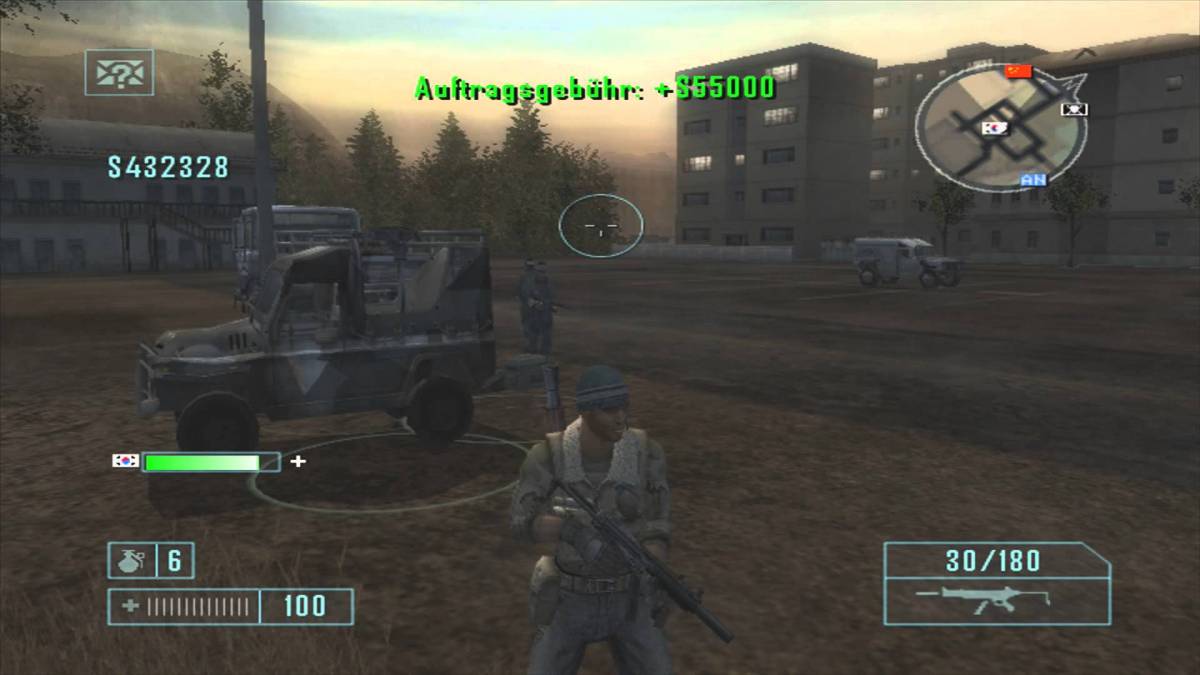
As you might expect, with 52 targets to deal with, plus 48 faction missions and a playground of destruction at your beck and call, Mercenaries can be a huge time sink. Even just the bare minimum critical path will take you at least 15 to 20 hours, but you’re doing yourself a disservice in that case. Mercenaries is one of those golden few open world games where practically none of it feels like busy-work. There is no Ubisoft map screen cluttered with icons for collectibles and “content” that makes your eyes go crossed. The collectibles are fairly numerous, but are entirely optional to your progress, and they do have interesting interplay with the game mechanics in several cases.
Destroying South Korean listening posts and collecting National Treasures, for example, nets a small reward from the PLA but also gains faction favor with them, which can be a nice way to get back in their good graces without having to bribe them (and in fact have them pay you for it), and destroying North Korean monuments and recovering WMD blueprints does the same for South Korea. National Treasures and recovered WMD each have a funny description, often with a fun pop culture reference, and collecting enough of them can unlock new player skins and cheats. 100%-ing the game unlocks a crate of overpowered cheat weapons, as well. Each of these side endeavors rewards the player with items and tangible things, and they are also more often than not placed in mission areas or other places the player has reason to be anyway – collectible hunting is almost never done for its own sake alone, and will often lead to greater discoveries, even if its just a fun new area to have a gunfight. Mercenaries is one of a tiny number of games I have ever cared enough to complete 100%, and I do not count a second of it as wasted time.
disguising the ugly
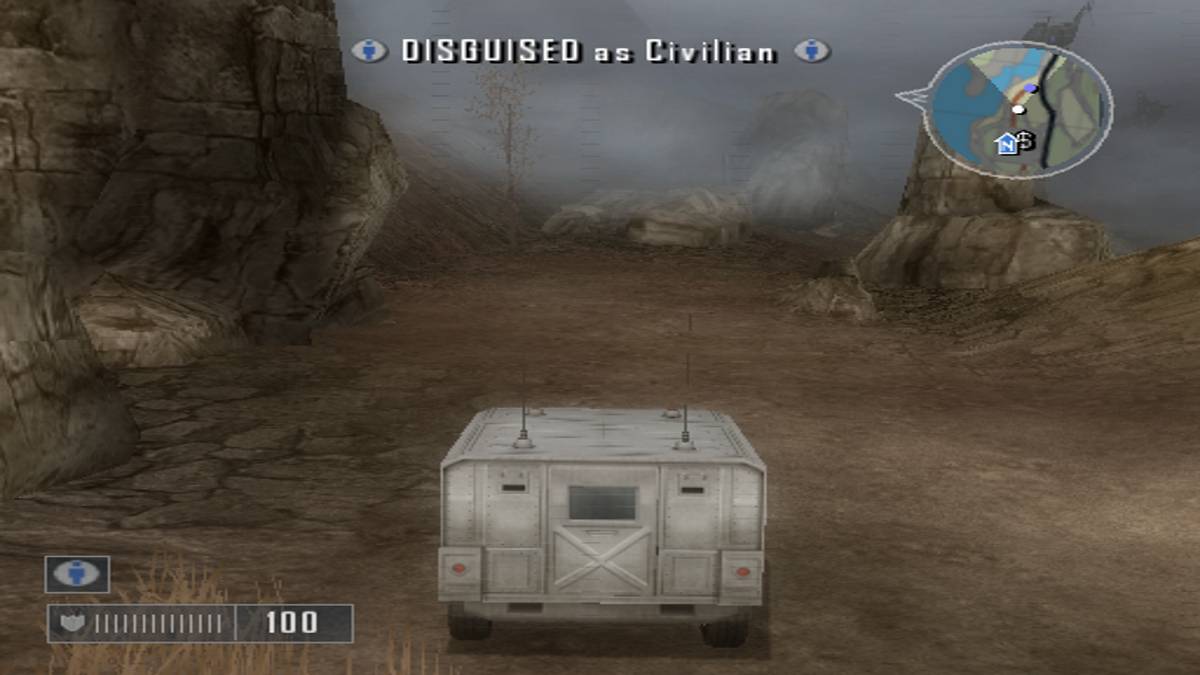
Now that I’ve spent 2000 words on sunshine and rainbows, let’s talk about some things in Mercenaries: Playground of Destruction that don’t hold up today, or never held up in the first place.
Foremost on my list of flaws in this gem is the disguise system. When operating a vehicle, remaining out of sight of witnesses for a short time allows you to become disguised as that faction. In theory, this is a great idea, allowing for more flexibility for a stealth approach given the game’s lackluster stealth options (read: there are none, unless you count Jennifer’s ability to cause enemies to target her slightly more slowly). In practice, however, it does very little to help and a lot to hinder.
When disguised, performing any action outside of simply driving around will blow your cover, even if you attack an enemy of the faction you’re disguised as! Disguised as North Korea and fire on some PLA? Must be the mercenary! Additionally, there are Officers in each faction who can immediately identify you and blow your cover if they get a look at you…even if you’re in a vehicle where they can’t see you, like a tank or APC. There are very few opportunities to make effective use of a disguise beyond getting part way into a base before running into an officer or bypassing a firefight, two things that don’t matter in the grand scheme of things given the game’s proclivity for mayhem at every turn.
Naturally, being disguised can also get you into some dangerous situations, especially in the early game when most of the good armored vehicles readily available are North Korean. Steal one of these, and you better be ready to drive around honking your horn constantly (a function that serves both to draw nearby allies into your vehicle and instantly drop your disguise), or face the wrath of every other faction you run into.
artificial STUPIDITY
On a related note, the AI for your allies especially is pretty lackluster. They’ll man your guns while you drive but not the other way around, leading to frustrating moments where your gunner continues to shoot at an enemy behind cover while ignoring the other threats in the open, or continue firing while his dumb buddy crosses his line of fire and dies. They’ll do this to you too, and will turn on you at the slightest provocation. Did a truck blow up that you may have had a hand in damaging at some point, slightly injuring an AN soldier? Have fun when the entire infantry squad, Bradley IFV and Apache helicopter all turn on you. Sometimes it will only occur on an individual basis, but much of the time the entire area will turn on you for even the most minute accidents.
The enemy AI at least has aggression going for them – vehicles who have their gunners killed will immediately begin trying to run you down until you hijack or kill them, and infantry will sometimes swarm you effectively or use their combined arms assets in tandem to overwhelm you. They’re just also content to run in circles and shoot the wall in front of them instead of you, or throw grenades much too close to themselves. The AI is where the jank I mentioned so long ago really comes in – most engagements, no matter how epic and satisfying, will have at least one moment where you laugh or shake your head at something stupid. It’s nothing game breaking, just don’t expect to rely on anyone but yourself.
nitpicks
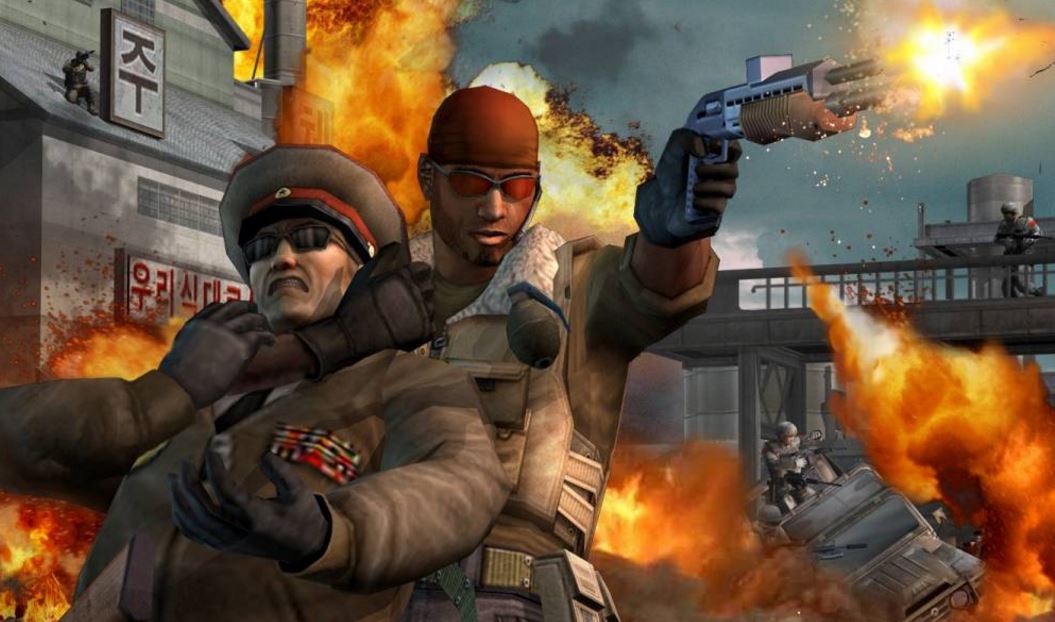
Other flaws are less systematic and smaller. Armored vehicles are heavily damaged by splash from explosions, making even misses by anti-armor weapons and running over cars (which explode) exceedingly dangerous in a way that underpowers the armor a bit. Your merc is also unable to swim or climb even the shallowest of inclines, making navigation a chore occasionally, especially when combined with the fairly unforgiving fall damage that will even kick in if you slide down an incline too long. Missions do not have checkpoints, making for some frustrating restarts, especially in missions with strict criteria for lucrative bonus objectives.
Though visuals are not as big of a deal to me as to many others, graphically it must be said that Mercenaries is a mixed bag even for its time. The first map especially is chock full of brown and gray which, while lending itself well to the aesthetic and atmosphere of the game, can get quite bland. The second, northern map is better in this regard, with snow-capped mountains and more wooded areas.
While I do enjoy the sound design for combat and the environment and adore the soundtrack, there are some dialog and audio ticks that get incredibly repetitive and annoying. Your character will make the same comment every time a homing missile is fired at their vehicle. On top of the fact that these missiles are extremely hard to avoid and give you very little warning, SAM sites will often fire multiple missiles at you quickly, especially if there are several in the area, and your merc will say the same phrase every. Single. Time.
wrapping up

Mercenaries: Playground of Destruction stands to this day of one of my favorite games of all time. Having played it again recently, I’m confident that nostalgia is not in the driver’s seat here. There is an undeniable amount of jank when it comes to physics, AI and a couple of questionable systems that feel half-baked.
With that said, Mercenaries did something new in 2005, and to this day I still don’t believe anything except maybe Just Cause has come close to replicating or improving it (Just Cause plays very different however). The compelling interaction between factions, the thrill of hunting for the Deck of 52 all over the countryside and finding all sorts of cool encounters and new toys along the way is something I’ve never seen before, at least certainly not executed in such an engrossing way. The sequel went all out on the goofy over-the-top action, but the original game maintained a somber military mood that propelled a surprisingly compelling narrative, punctuated by brief moments of dark comedy and player-driven hi-jinks.
Mercenaries is unfortunately a series in stasis at the moment; EA killed off Pandemic after the lackluster sequel as well the developer working on the third game, Danger Close Games (now DICE LA), when they cancelled that game. Even if we did get another, it is doubtful that the love and care that went into the first game will be behind any new game – it would likely be a paint-by-numbers open world action game, sure to make EA money and get good reviews, but it will do so without the soul and uniqueness of its originator.
Some of the coverage you find on Cultured Vultures contains affiliate links, which provide us with small commissions based on purchases made from visiting our site. We cover gaming news, movie reviews, wrestling and much more.


